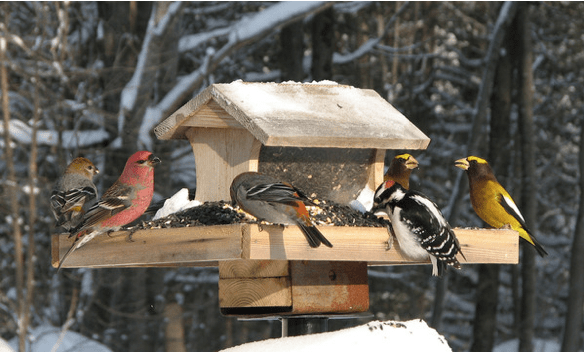Focused Exploration
- Provide the students with time to explore an outdoor area (ideally one they are less familiar with)
- Ask them to search for animal and bird signs – if possible ask the children to come back to you when they feel they have completed this task, if your students are not at this level, feel free to set a time.
- Afterwards share as a group the various things they found.
Play the squirrel game (Camp Kawartha)
- Talk about the different types of squirrels that you can see in your neighbourhood
- Have half the class be black/grey squirrels and the other half be red squirrels
- Give each student 5 popsicle sticks or painted rocks
- Those who are red squirrels have to hide all of their items together and those who are black/grey squirrels have to hide them in tiny bundles or individually
- This mimics how the two types of squirrels hide their food!
- After they are hidden the teacher (and maybe a few students) are identified as bluejays and foxes.
- Now the squirrels have to rush back out to collect (and remember!) where their food is hidden. The blue jay(s) are trying to steal the food and the foxes are trying to eat the squirrels and the blue jays.
- Was it hard to remember where your food was? Did you easily escape the foxes and bluejays?
Examine the human/nature relationship
- Head outside with your class and explore the neighbourhood
- Some poignant questions from the curriculum are as follows:
- What are some of the good things about the natural features in our neighbourhood? How can we be more responsible and take better care of them?
- How are the ways in which we interact with the natural environment different from the ways we interact with human-built features?
- What are some ways in which people have had an impact on the natural features in the community?
- What happens when a new subdivision or mall goes up where there used to be trees or field grasses?
- What happens if the water is not safe to drink, wash, or swim in?
- It would be beneficial to talk to the class about things they would like to change, how we can change these aspects, condense the wishes down to one tangible thing that your class could do to benefit the neighbourhood/neighbourwood (ex: composting, planting native plants, labelling garbage and recyling bins, picking up trash, etc.)
Read: Martin and the River by Jon-Erik Lappano, illustrated by Josée Bisaillon
- Ideally read the book to your class outside.
Read: We All Play by Julie Flett
- Ideally read the book to your class outside.
Read: Stand Like a Cedar by Nicola I. Campbell, illustrated by Carrielynn Victor
- Ideally read the book to your class outside.
Math fun
- Head outside with your class and collect acorns
- Sorting acorns or pinecones according to size (bigger, smallest, largest, longest, etc.)
- Counting acorns within these categories, ones with tops or without
- These acorns can also be planted and kept in the freezer until spring when they will sprout.

